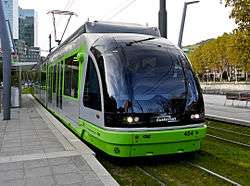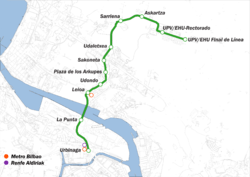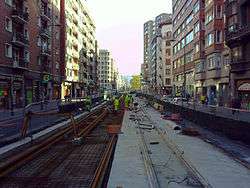Euskotren Tranbia
Euskotren Tranbia, formerly known as Euskotran (abbreviation for "Eusko Tranbia" which means Basque Tram) is an Urban transit tramway system that operates lines in the cities of Vitoria-Gasteiz and Bilbao, plus one under construction in Leioa and another one, (also under construction) in the city of Barakaldo, all of them in the Basque Country. It began operations for the first time in Bilbao in 2002 and in Vitoria in 2008. It is one of the four commercial brands under which Basque Railways operates, as a public company managed by the Basque Government. The entire network, as the Euskotren Trena network, uses 1,000 mm (3 ft 3 3⁄8 in) narrow gauge rail tracks.
 | |
 | |
| Overview | |
|---|---|
| Owner | Basque Railways |
| Locale | Álava, Biscay (Basque Country) |
| Transit type | Tram |
| Annual ridership | 3 million (Bilbao, 2018) [1] 8 million (Vitoria-Gasteiz, 2018)[2] |
| Headquarters | 8, Atxuri Street, Bilbao, Biscay 2, General Álava, Vitoria-Gasteiz, Álava |
| Website | www |
| Operation | |
| Began operation | 2002 (Bilbao) 2008 (Vitoria-Gasteiz) |
| Technical | |
| Track gauge | 1,000 mm (3 ft 3 3⁄8 in) metre gauge |
| Electrification | (?) |
Euskotren Tranbia operates the tram services, while Euskotren Trena operates the commuter rail networks, Euskotren Autobusa the bus services and Euskotren Kargo the freight rail services. Since 2006 Euskotren Tranbia, formerly known simply as "Euskotran", is the commercial brand for operator of the tram network, while the network itself is owned by the public entity Euskal Trenbide Sarea (Basque Railway Network). In 2012 the commercial brand changed from Euskotran to Euskotren Tranbia with the word tranbia being Basque for "tram".
Services
Introduction
Euskotren Tranbia operates tram networks in Vitoria-Gasteiz (province of Álava) and Bilbao (province of Biscay), plus one being under construction in Leioa to connect in the future the campus of the University of the Basque Country with Leioa and then with the Urbinaga metro station, in Sestao. The first network, then named EuskoTran and later Euskotran started in Bilbao in 2002, after two years under construction, connecting the Bilbao-Atxuri Station with Uribitarte. The line was eventually expanded to the Guggenheim Museum Bilbao, the hospital of Basurto and finally La Casilla. The tramway of Vitoria-Gasteiz opened in 2008 and has a Y-shaped network, with two different lines that cross the city from south to north.
Euskotran Tranbia runs on a mixture of street track shared with other traffic, dedicated tracks and grass tracks. It also shares dedicated tracks with the local bus services, TUVISA in Vitoria and Bilbobus in Bilbao.
Stops
The tram has its own, distinguishable stops, some of them shared with bus systems and with low platforms. The stops of Bilbao-Atxuri Station, Ribera and Abando, all of them in Bilbao, do not have their own separate stop, they use the sidewalk. Except for Bilbao-Atxuri and Legibitzarra/Parlamento, the second one in the Vitoria network, all stops are unstaffed and rely on automated ticket machines. All the stations have displays and screens with the network map, the current time and temperature and the frequencies. Due the low platforms, the access between them involves crossing the tracks by pedestrian level crossing. They are virtually level with the doors and are all wider than 2 m (6 ft 7 in). This allows wheelchairs, prams, pushchairs and the elderly to board the tram easily with no steps. In street sections, the pavement is integrated with the tram stop. The Bilbao line has 14 stops, while the Vitoria one has 20.
Lines and stations

The Euskotren Tranbia networks serves the following stations.
- Bilbao, Biscay

- Vitoria-Gasteiz, Álava
Bilbao's Tram
|
Ibaiondo line (Vitoria's Tram)
|
Abetxuko line (Vitoria's Tram)
|
Fares and ticketing
Bilbao's tram uses both regular paper tickets than can be acquired in the automated machines in every stop; there are single, daily and monthly tickets available. The ticket pricing is not based on zone-based rules, as there's a unique price for the whole network. The Barik card is available in the whole network. A simple ticket costs €1,40 (regular ticket) or €0,70 (Creditrans) as of 2012.
Vitoria's tram uses both regular paper tickets and the electronic cards BAT (and derivates like Barazi), which also work for the TUVISA bus system. The TUVISA bus cards are also valid. The ticket pricing is not based on zone-based rules, as there's a unique price for the whole network. A simple ticket costs €1,25 (regular ticket) or €0,66 (BAT or bus cards) as of 2012.
Rolling stock
Euskotren Tranbia operates with the Urbos series produced by the Basque company CAF.[3]
Current fleet
| Class | Image | Type | Cars per set | Routes operated | Built | Notes |
|---|---|---|---|---|---|---|
| Urbos 1 |  |
Light rail tramway (electric unit) | 3 | Bilbao's Tramway | 1999-2006 | |
| Urbos 2 |  |
Light rail tramway (electric unit) | 5 | Vitoria's Tramway | 2006–present | |
Each 25 m (82 ft) long tram can carry 192 people, 50 of them seated (about the capacity of three buses). Access to the trams is at platform level, making it easy for handicapped passengers to get on and off through the tram's eight doors. Speakers in the trams play music and announce each stop. All trams are equipped with air conditioning.
Livery
The trams are painted in grey and green stripes, the colours of Euskotren Tranbia.
Future developments
Leioa's Tram

The tramway for the municipality of Leioa, in the Greater Bilbao area is under construction and is going through two phases, currently being on the first one which is the construction of the future depots and offices. The second phase will involve the line itself including the rail track and stops from the University of the Basque Country campus to downtown Leioa. It will include nine stations:
- University campus II (terminus)
- University campus I
- Sarriena
- Rotonda de Sarriena
- Edificio consistorial/Udaletxea
- Avenida Sabino Arana
- Plaza de los Arkupes/Sakoneta
- Boulevard Udondo
- Leioa (connection with Line 1 of Metro Bilbao)
A third phase would make the tramway cross the Estuary of Bilbao and connect Leioa with the Left Bank with two extra stations:
Planned developments

Vitoria's Tram extension
There are plans to expand the Vitoria's tram network to the south, across the Renfe train station and reaching the campus of the University of the Basque Country.
Bilbao's Tram extension
There are planned extensions for the tramway of Bilbao, including reaching the Deusto and Basurto-Zorroza districts in the northern area and Bolueta and Etxebarri in the southern Greater Bilbao.[4]
Barakaldo's Tram
There are plans to create a tram network in the municipality of Barakaldo, in the Greater Bilbao area, which would start in Urbinaga station (where it would connect with Leioa's tram) and from there create a circular line through the center of the city. The tramway would have 15 stops within Barakaldo plus two in Sestao, where it will connect with the Leioa's line.
See also
References
- "El tranvía de Bilbao se prepara para poder operar con unidades más largas". Deia.eus (in Spanish). 27 April 2019. Retrieved 2 December 2019.
- "El tranvía de Vitoria cumple 10 años con el 90% de los viajeros satisfecheos". Diario Vasco (in Spanish). 21 December 2018. Retrieved 2 December 2019.
- "100% LOW FLOOR BILBAO STREETCAR". CAF. Archived from the original on 17 December 2009. Retrieved 16 January 2010.
- http://www.elcorreodigital.com/vizcaya/20090730/vizcaya/piden-gobierno-vasco-garantice-20090730.html